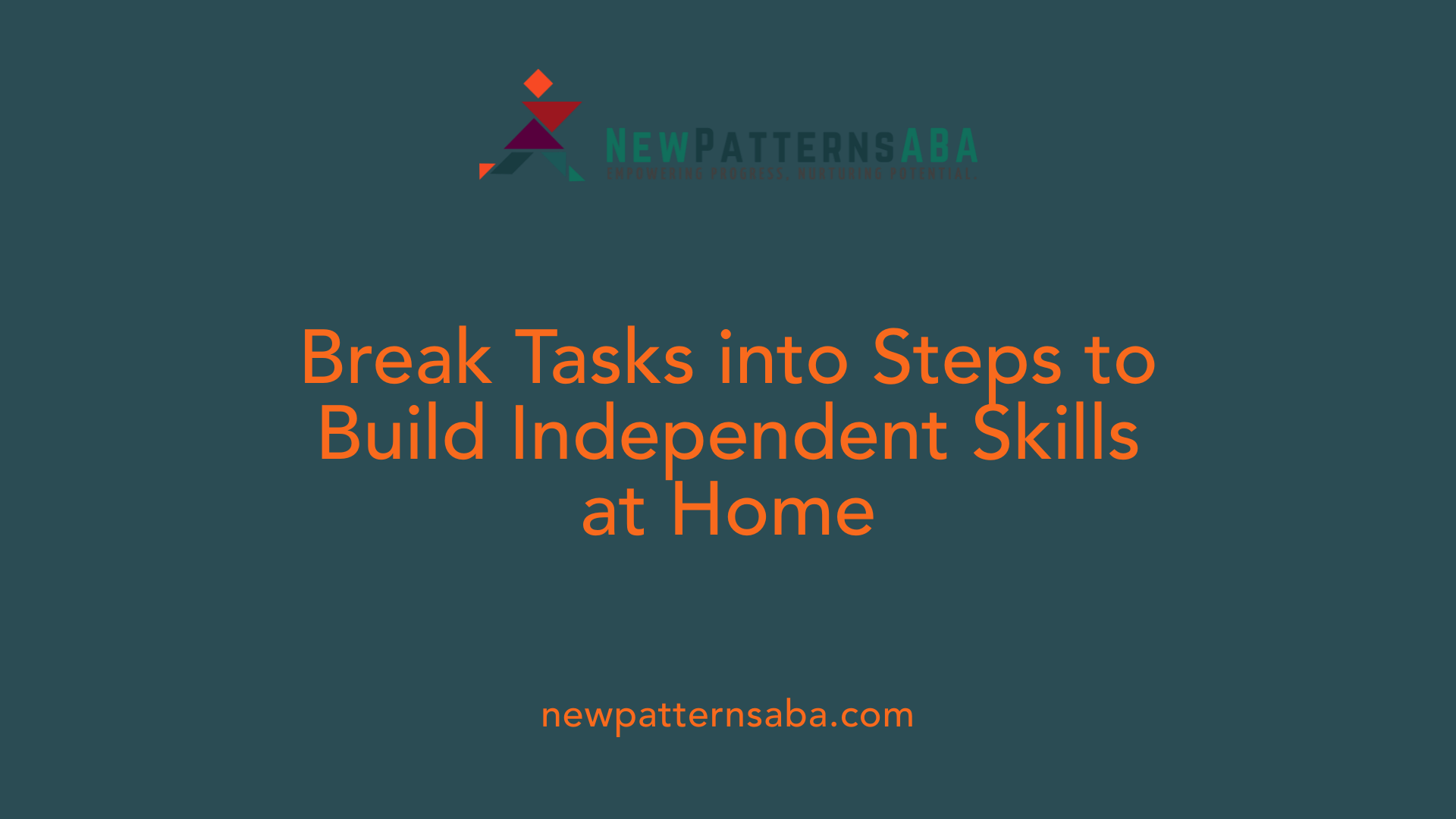Introduction to ABA for Independence
Applied Behavior Analysis (ABA) is a scientifically validated approach that helps children develop essential life skills while reducing problematic behaviors. Its application at home offers a practical, consistent, and supportive environment for fostering independence. This article explores how parents and caregivers can effectively use ABA techniques to cultivate autonomy in children, encouraging confidence and self-sufficiency in daily routines and activities.
Understanding ABA and Its Role in Building Independence

What is Applied Behavior Analysis (ABA) and how does it work?
Applied Behavior Analysis (ABA) is a scientific approach that focuses on understanding and shaping behavior. It uses proven techniques to encourage positive behaviors and reduce challenging ones. ABA centers on reinforcement — rewarding desired behaviors to increase their occurrence. This method involves analyzing what triggers behaviors and how to modify environment factors to support learning.
Core components of ABA include Discrete Trial Training (DTT), which breaks skills into small steps and rewards mastery, and Natural Environment Teaching (NET), helping children generalize skills in real-world situations. It also employs techniques like task analysis, prompting, fading, and positive reinforcement to promote skill-building.
How can ABA techniques foster independence at home?
Implementing ABA at home significantly supports children in developing self-care and daily living skills. By breaking complex tasks into smaller, manageable steps—such as brushing teeth or tidying up—children can learn gradually through a process called task analysis. Visual supports like schedules, checklists, and timers help children visualize routines and stay on track.
Positive reinforcement plays a vital role; rewarding efforts and completed tasks with praise, stickers, or preferred activities motivates children to repeat desired behaviors. Consistent practice across different environments, combined with patience and collaboration with professionals, helps ensure that skills are applied and retained in everyday life.
What practical methods support independence through ABA at home?
Parents and caregivers can apply several straightforward strategies to promote independence:
- Structured routines: Use visual schedules to provide predictable daily plans.
- Task breakdown: Divide larger tasks into smaller steps with visual cues.
- Prompting and fading: Offer verbal prompts or physical assistance initially, then gradually reduce support.
- Positive reinforcement: Reward children with praise, token systems, or favorite activities for completed tasks.
- Real-life practice: Incorporate skills into everyday activities like chores, cooking, and shopping.
- Collaborative goal setting: Engage children in choosing targets to foster motivation.
Monitoring progress, providing immediate feedback, and collaborating with ABA professionals further maximize success.
Which ABA techniques are most effective for promoting independence?
Several key techniques support the development of independence:
- Task analysis: Decomposing complex skills into simple steps.
- Prompting and fading: Guiding children with cues and gradually removing them.
- Visual supports: Using picture schedules, charts, and videos to teach and reinforce skills.
- Functional Communication Training (FCT): Teaching children to express their needs effectively, reducing frustration.
- Encouraging choices: Teaching decision-making through options and problem-solving.
- Generalization: Practicing skills in various settings to promote transferability.
When combined, these strategies create a comprehensive framework for cultivating independence at home and in community settings.
What strategies within ABA support enhancing independence through skill development at home?
In-home ABA strategies emphasize continuous learning and practice. Family involvement is crucial, with caregivers trained to implement routines, prompts, and reinforcement techniques. Behavioral strategies like shaping, differential reinforcement, and behavior chaining facilitate skill acquisition.
Visual aids, such as checklists, cue cards, and digital applications, support learning and independence across different activities. Consistent reinforcement, immediate feedback, and real-world application help children build confidence and self-management skills.
Employing these methods within a personalized plan ensures that children develop essential life skills, leading to greater autonomy and improved quality of life.
Visual Supports and Schedules for Daily Tasks

What types of visual supports are used in ABA to promote independence?
Visual supports are visual cues designed to assist children in understanding and following routines, which are critical for developing independence. Common types include visual schedules, checklists, timers, and picture cards. Visual schedules present sequences of activities or steps necessary to complete a task, like brushing teeth or dressing. Checklists help children track their progress by ticking off completed steps, and timers can signal when to transition between activities.
These supports can be customized with photos, symbols, or written words based on the child's age and learning style. Video modeling is another form of visual aid that demonstrates desired behaviors and routines.
How do visual supports assist in helping children follow routines?
Visual supports serve as clear, visual reminders of what needs to be done, reducing confusion and dependency on verbal instructions. They encourage children to predict what comes next, fostering a sense of control and responsibility.
Using visual schedules, children can independently check what they are supposed to do, which reinforces routine adherence. Checklists enable them to actively participate in their progress, boosting motivation and confidence.
Timers help children understand the passage of time, preparing them for transitions and reducing anxiety. Over time, consistent use of these supports helps children develop internal cues for completing tasks, gradually building independence.
Can you provide examples of visual supports in daily self-care and chores?
Certainly! Visual supports are widely used in personal hygiene and household chores:
| Visual Support Type | Example | Purpose |
|---|---|---|
| Visual Schedule | Pictures of steps for toileting (pulling down pants, wiping, flushing, washing hands) | Guides children through self-care routines independently |
| Checklists | Step-by-step list for getting dressed (shirt, pants, shoes) | Tracks progress and reinforces task completion |
| Timers/Clocks | Visual timer for brushing teeth (set for 2 minutes) | Ensures appropriate time spent on hygiene practices |
| Charts/Reward Systems | Sticker chart for chores like setting the table or making bed | Motivates children by rewarding consistent effort |
| Card Sets | Picture cards showing household chores (vacuuming, laundry) | Supports understanding and following chore routines |
Integrating these visual tools into daily life promotes consistency and helps children carry skills learned during therapy into real-world settings. They act as reliable cues, encouraging children to become more autonomous in managing personal habits and household responsibilities.
How can ABA techniques further promote independence at home?
ABA techniques such as task analysis, which breaks complex skills into smaller, manageable steps, are fundamental. For example, teaching a child to prepare a simple snack can be broken into gathering ingredients, opening containers, and cleaning up afterward. Positive reinforcement plays a vital role; rewarding successful completion of each step with praise, tokens, or preferred items motivates children to repeat behaviors.
Prompting strategies like visual prompts, verbal cues, or physical guidance are used initially to support skill acquisition. These prompts are gradually faded to foster independence.
Behavior management tools such as redirection and extinction help address problematic behaviors that interfere with learning new skills. Consistent practice, collaboration with professionals, and celebrating small successes further bolster progress.
What is the role of technology and caregiver involvement in supporting independence?
Innovative tools such as interactive software, virtual reality social simulations, and data tracking apps personalize therapy and make learning engaging. These technologies help children generalize skills across settings.
Caregiver involvement is essential. Training parents and family members to implement ABA strategies like visual supports, routines, and role-playing ensures skills are reinforced consistently outside therapy sessions. This hands-on practice promotes generalization and helps children develop independence in daily routines.
Overall, combining visual supports with evidence-based ABA techniques creates a supportive environment that encourages children to learn, practice, and retain skills necessary for independent living.
Task Analysis for Self-Care and Household Chores

How can ABA techniques be used at home to foster independence in children?
ABA techniques are highly effective in helping children develop independence within the home setting. One of the foundational methods is task analysis, which involves breaking down complex daily routines—such as brushing teeth, getting dressed, or tidying up—into smaller, manageable steps. This approach makes tasks less overwhelming and easier to learn.
Visual supports play a vital role in this process. Tools like visual schedules, picture cues, and timers provide clear, concrete guidance that children can follow, increasing their understanding and confidence in completing routines independently. For example, a visual timetable for morning routines might include pictures of brushing teeth, combing hair, and putting on a coat.
Positive reinforcement is another cornerstone. Offering praise, stickers, or small rewards when children complete steps successfully encourages ongoing effort and fosters motivation. Caregivers can promote skill transfer across different environments by practicing routines regularly and maintaining consistency with prompts and reinforcement, helping children generalize skills from therapy to daily life.
Overall, structured, personalized ABA strategies—incorporating task analysis, visual supports, and positive rewards—are instrumental in nurturing children’s independence and self-sufficiency at home.
What are practical methods for applying ABA techniques at home to support independence?
Implementing ABA strategies practically requires caregivers to establish structured routines with visual supports. Creating visual schedules for daily activities, such as morning preparations or bedtime routines, offers predictability that reduces anxiety and prompts children to perform tasks independently.
Breaking down complex tasks into smaller steps using task analysis is crucial. For example, helping a child learn to dress involves steps like choosing clothes, putting on a shirt, and fastening buttons. Using prompts—visual cues, physical assistance, or verbal hints—can support children during initial learning phases. These prompts are gradually reduced (faded) as children become more competent.
Positive reinforcement techniques, such as praise, stickers, or preferred activities, motivate children to try and succeed in tasks. Consistency across different environments amplifies learning—parents working collaboratively with therapists ensure that strategies are aligned and reinforcement is meaningful.
Monitoring progress allows for tailored adjustments. Immediate feedback and celebrating small successes keep children engaged. By integrating these methods—routine building, prompt fading, reinforcement, and supervision—families can support their children’s move toward greater independence.
How can ABA strategies be implemented at home to develop independence skills?
To foster independence using ABA strategies at home, caregivers should develop consistent daily routines enhanced with visual aids like checklists and schedules. These supports guide children through daily activities and establish clear expectations.
Breaking down tasks such as setting the table or packing their bag into small, sequential steps ensures children can learn skills systematically. Repeated practice with immediate positive reinforcement increases the likelihood of skill mastery.
Engagement in practical activities, including household chores and decision-making tasks, encourages children to become autonomous. For example, allowing a child to choose between two outfits not only builds decision-making skills but also builds confidence.
Family involvement is critical. Caregivers should practice routines regularly, use consistent prompts, and celebrate successes to help children internalize skills. Collaborating with ABA professionals can further refine strategies to maximize independence.
Ultimately, these approaches build a foundation for children to manage daily responsibilities confidently, promoting growth in their self-care and household management abilities.
Prompting and Fading Techniques

How are prompts used to guide behavior?
In ABA, prompting is a strategy used to assist children in performing desired behaviors. Prompts can take various forms, including verbal instructions, physical guidance, visual cues, or gestures that help clarify what the child should do next. For example, a teacher or parent might give a verbal prompt like saying, "Pick up the brush," or physically guide a child's hand to the toothbrush. Visual supports, such as picture schedules or checklists, serve as prompts that children can refer to when completing tasks.
The goal of prompting is to model and encourage correct behaviors while providing enough support to ensure success. Consistent and appropriate prompts can effectively teach new skills, especially when a child is learning routines like grooming, dressing, or household chores.
How does fading prompts foster independence?
Fading involves gradually reducing the level of assistance provided through prompts once the child demonstrates understanding or skill mastery. This process ensures that the child learns to perform tasks independently without relying heavily on prompts.
For instance, after initially guiding a child's hand to brush teeth, a parent may slowly reduce physical guidance, moving toward verbal cues and eventually expecting the child to complete the task independently. Visual supports also move from heavily referenced to less frequent, encouraging internalization of routines.
Fading is crucial because it promotes autonomy by fostering confidence and self-sufficiency. It helps children transition from dependence on external cues to performing skills independently, which is vital for daily living and social participation.
What ABA techniques can be used to promote independence development in children?
ABA techniques that support independence include task analysis, which breaks down complex skills into small, manageable steps. For example, teaching a child to brush their teeth involves steps like picking up the toothbrush, applying toothpaste, brushing, rinsing, and putting the toothbrush away.
Positive reinforcement plays a significant role; rewarding each successful step with praise, a sticker, or a preferred activity encourages continued skill practice. Visual supports such as picture schedules or video models help children understand routines and independently complete tasks.
Encouraging children to make choices and solve problems fosters decision-making and self-management skills. Generalizing these skills across different environments, such as home, school, or community, ensures that children can apply their skills broadly. Assistive technologies like communication apps or timers further support independence by providing accessible means for expressing needs or managing tasks.
What strategies within ABA support enhancing independence through skill development at home?
At home, ABA strategies such as functional communication training teach children to express their needs confidently, reducing frustration and promoting autonomy. Behavior chaining connects individual steps in complex activities, such as preparing a simple snack, to reinforce coordinated efforts.
Consistent use of visual aids, checklists, and prompts helps children learn routines like dressing or setting the table. Reinforcement, whether through praise, tangible rewards, or preferred activities, motivates children to practice and consolidate these skills.
Family involvement is vital — caregivers are trained to implement ABA techniques such as differential reinforcement, which encourages desirable behaviors, and extinction, to reduce undesirable behaviors. These methods foster independence by reinforcing specific skills and reducing reliance on external prompts.
Technology tools, including visual schedules or apps that guide daily routines, enhance learning and generalization. The combination of these ABA techniques creates a supportive environment where children can develop self-care, social, and problem-solving skills necessary for greater independence in daily life.
Building a Foundation for Independence
Implementing ABA techniques in the home requires consistency, patience, and collaboration. By leveraging tools like visual supports, breaking tasks into smaller steps, reinforcing successes, and systematically fading prompts, caregivers can foster a child's independence and self-sufficiency. As children gain confidence in their abilities through these structured strategies, they become more equipped to handle everyday activities independently, laying the groundwork for lifelong skills that enhance their overall quality of life and integration into various social settings.
References
- Using ABA Techniques to Improve Daily Skills in Children
- Exploring Examples of ABA Therapy - First Step Arkansas
- ABA Therapy Strategies for Children with Autism: Fostering Growth ...
- How ABA Therapy Supports Independence in Daily Activities
- Benefits of In-Home ABA Therapy for Children - UTBS
- How ABA therapy can help children with autism develop ...
- Independence in Individuals with Autism: Role of ABA Therapy





